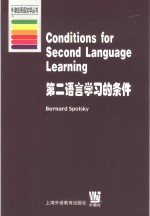
- 作 者:(以色列)Bernard Spolsky著
- 出 版 社:上海:上海外语教育出版社
- 出版年份:2000
- ISBN:7810468596
- 标注页数:272 页
- PDF页数:287 页
请阅读订购服务说明与试读!
订购服务说明
1、本站所有的书默认都是PDF格式,该格式图书只能阅读和打印,不能再次编辑。
2、除分上下册或者多册的情况下,一般PDF页数一定要大于标注页数才建议下单购买。【本资源287 ≥272页】
图书下载及付费说明
1、所有的电子图书为PDF格式,支持电脑、手机、平板等各类电子设备阅读;可以任意拷贝文件到不同的阅读设备里进行阅读。
2、电子图书在提交订单后一般半小时内处理完成,最晚48小时内处理完成。(非工作日购买会延迟)
3、所有的电子图书都是原书直接扫描方式制作而成。
ContentSIntroduction 1
The task of a general theory 1
Other models 5
1 A general theory of second language learning 11
Features of a general theory 11
Conditions for second language learning 14
An overview 25
Interlanguage 30
2 Knowing a language 30
Variability 36
Variety of language 41
3 Knowing how to use a language 46
Duality of knowledge and skills 46
Communicative competence 51
The view from theory 56
4 Structures and functions 59
The approach from language testing 59
Testing structural knowledge 60
Testing integrated functions 61
Necessary or imposed order 65
Goals for learning Hebrew—an example 66
5 Measuring knowledge of a second language 71
The idea of general proficiency 71
Relating the models 76
Linguistic outcomes in a general theory 78
6 The psycholinguistic basis 83
The human learner 83
The argument from linguistic theory 89
The relevance of age 91
7 Ability and personality 100
Individual differences 100
Intelligence 102
Aptitude 104
Learning styles and strategies 108
Personality 110
Anxiety in second language learning 113
8 The linguistic basis 117
Contrastive analysis 117
Universals and contrastive analysis 121
Universals and second language learning 124
9 The social context 131
Social factors 131
The stylistic dimension 136
The acculturation model 142
10 Attitudes and motivation 148
Language learning motivation 148
The socio-educational model 154
Attitudes,motivation,and acculturation 157
Social basis of motivation 160
11 Opportunities for second language learning 166
Opportunities for learning 166
Informal and formallearning 170
Pidginization and creolization 173
Foreigner talk 178
12 Formal instruction 187
The nature and effect of input 187
The value of formalinstruction 193
The approach from teaching 197
Testing a preference model 202
13 Testing the model 202
Defining the outcomes 204
Ability and personality 205
Anxiety 207
Attitudes and rationales 207
The effects of attitudes 209
Opportunities for learning 211
A causal model 213
Choosing a model 221
14 The form of a general theory 221
Beyond the preference model 225
Extension of the theory to language loss 228
Conclusion 229
AppendixCase study:Hebrew in a Jewish school 232
The case study 232
The reliability and validity of self-assessment 233
Tables 235
Bibliography and citation index 244
Index 265
